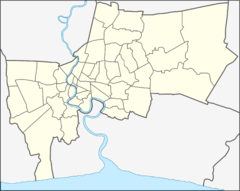Wat Pavaranivesh Vihara Rajavaravihara (Thai: วัดบวรนิเวศวิหารราชวรวิหาร; RTGS: Wat Bowon Niwet Wihan Ratchaworawihan, IPA: [wát bɔwɔːn níʔwêːt wíʔhǎːn râːttɕʰawɔːráʔwíʔhǎːn]) is a major Buddhist temple (wat) in Phra Nakhon district, Bangkok, Thailand.
| Wat Pavaranivesh Vihara | |
|---|---|
 View of the temple | |
| Religion | |
| Affiliation | Thammayut Buddhism[1] |
| Standort | |
| Land | Phra Nakhon district, Bangkok, Thailand |
| Geographic coordinates | 13°45′37.2″N 100°29′59.5″E / 13.760333°N 100.499861°E |
| Website | |
| http://www.watbowon.org | |
The temple is a center of the Thammayut Nikaya order of Thai Theravada Buddhism, it is the shrine-hall of Phra Phuttha Chinnasi (พระพุทธชินสีห์), a statue of the Buddha which dates to around 1357. Bowonniwet has been a major temple of patronage for the ruling Chakri dynasty.[2] It is where many royal princes and kings studied and served their monkhood, including King Bhumibol[1] and his son, the present king Vajiralongkorn.
Architecture
The golden chedi at the wat's shrine carries the relics and ashes of Thai royals.[1] The two viharas are closed to public. The T-shaped bot holds a magnificent Sukhothai-period Buddha, cast in 1257 CE to celebrate freedom from the Khmers.[1]
The murals on the bot's interior walls were traditionally light and limited in their subject matter and style. They were painted to appear three-dimensional.[1] Monk artist Khrua In Khong introduced Western style in the murals depicting Buddhist subjects.[1]
Royal patronage and history
In 1836, Prince Bhikkhu Mongkut (ordination name: Vajirañāṇo) arrived at the temple and became its first abbot, founding the Thammayut Nikkaya order. He stayed at the temple for 27 years before acceding the throne of Siam as King Rama IV.[3]
His great-grandson, King Bhumibol Adulyadej (Rama IX; ordination name: Bhumibalo), was ordained a monk at Wat Phra Kaew, and resided in Bowonniwet for 15 days in 1956. Bhumibol's mentor, Somdet Phra Yanasangworn, eventually became abbot of the temple, and later the Supreme Patriarch of Thailand. In 1978, King Bhumibol's son, King Vajiralongkorn (Rama X; ordination name: Vajirālankaraṇo), was also ordained and spent 15 days at Bowonniwet. Several of his sons from his second wife, Yuvadhida Polpraserth, later did the same.[4]
In October 1976, exiled dictator and former Prime Minister, Field Marshal Thanom Kittikachorn, returned to Thailand as a novice monk to enter Bowonniwet. This sparked large public demonstrations and a bloody crackdown that became known as the Thammasat University massacre or the "6 October Event".
Media
-
Statue of King Rama IV in a niche at Wat Bowonniwet
-
Royal emblem of Rama IV on the gable-board of the ubosoth
-
The statue of Phra Phuttha Chinnasi in the main shrine hall
-
Phra Tamnak Phet (Royal Diamond Residence)
-
Buddha's footprint in Wat Bowonniwet, Bangkok
Notes
References
- Liedtke, Marcel (2011), Thailand- The East (English Edition), Norderstedt: Books on Demand GmbH, ISBN 978-3-8423-7029-6
{{citation}}: Cite has empty unknown parameter:|coauthors=(help) - Macdonald, Phil (2009), National Geographic Traveler Thailand, England: National Geographic Society, ISBN 978-1-4262-0408-1
{{citation}}: Cite has empty unknown parameter:|coauthors=(help) - Hoskin, John (2006), Thailand, London: New Hollands Publishers (UK) Ltd, ISBN 978-1-4262-0408-1
{{citation}}: Cite has empty unknown parameter:|coauthors=(help) - Williams, China, Thailand, Lonely Planet
{{citation}}: Cite has empty unknown parameter:|coauthors=(help) - DhammaThai.org A Guide to Meditation Centres in Thailand: Wat Bovornives Vihara, last retrieved 15 September 2006
